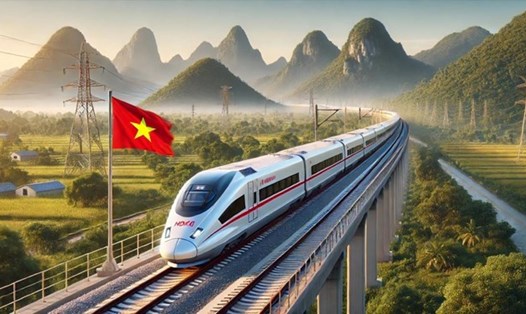On the afternoon of November 30, the majority of National Assembly deputies voted to pass the "Resolution on investment policy for the North-South high-speed railway project".
There were 454 delegates participating in the vote, of which 443 delegates approved; 7 delegates disapproved; 4 delegates did not vote.
The resolution clearly states that the construction of a high-speed railway line with a total length of about 1,541 km; starting point at Ngoc Hoi station (Hanoi capital), ending point at Thu Thiem station (Ho Chi Minh City), passing through 20 provinces and centrally-run cities including: Hanoi capital, Ha Nam, Nam Dinh, Ninh Binh, Thanh Hoa, Nghe An, Ha Tinh, Quang Binh, Quang Tri, Hue, Da Nang, Quang Nam, Quang Ngai, Binh Dinh, Phu Yen, Khanh Hoa, Ninh Thuan, Binh Thuan, Dong Nai, Ho Chi Minh City;
New investment in the entire double-track line with a gauge of 1,435 mm, a design speed of 350 km/h, a load capacity of 22.5 tons/axle; 23 passenger stations, 05 freight stations; vehicles, equipment; high-speed railway for passenger transport, meeting dual-use requirements for national defense and security, and can transport goods when necessary.
Reporting on the summary of the acceptance, revision and explanation of the Project investment policy, Chairman of the Economic Committee Vu Hong Thanh said that the National Assembly Standing Committee agreed with the majority of delegates' opinions on the necessity of investing in the Project.
The project has been studied and prepared for investment for a long time (about 18 years) and referred to the experience in some countries with high-speed railway development in the world to complete the Pre-Feasibility Study Report. In which, the analysis and calculation with the forecast results of transportation demand, potential, and current position of Vietnam are suitable conditions for implementing the investment project.

At the same time, the Politburo and the Central Executive Committee have thoroughly discussed the investment policy, factors and conditions for implementing the Project. However, the calculations at the pre-feasibility study stage are only preliminary, so it is recommended that in the Project feasibility study stage, the Government direct relevant agencies to continue to make specific calculations and carefully assess factors and risks to have appropriate solutions to ensure the feasibility of the Project.
There are suggestions to extend the scope of the Project from Lang Son to Ca Mau Cape and to implement it in phases; it is suggested to connect the Project to the Ho Chi Minh City - Can Tho railway line to ensure synchronization.
Regarding this issue, the National Assembly Standing Committee said that according to the Railway Network Planning for the period 2021 - 2030, with a vision to 2050, it has determined to develop new railway routes from Lang Son to Can Tho, including 03 sections: Lang Son (Dong Dang) - Hanoi; Hanoi - Ho Chi Minh City; Ho Chi Minh City - Can Tho to connect dynamic regions, urban areas, major economic centers and ensure national defense and security on the North - South economic corridor.
Because the railway sections from Lang Son to Can Tho have different transportation needs, the technical standards and types of railways are also different and are researched and invested in according to independent projects, suitable for the transportation needs of each section and the ability to mobilize resources.
Of which, the Lang Son - Hanoi section, 156 km long, is a standard railway, detailed planning is being studied and expected to be invested before 2030; the Hanoi - Ho Chi Minh City section, 1,541 km long, is a high-speed railway, striving to start construction in 2027; the Ho Chi Minh City - Can Tho section, 174 km long, is a standard railway, being prepared for investment, expected to be invested before 2030.











